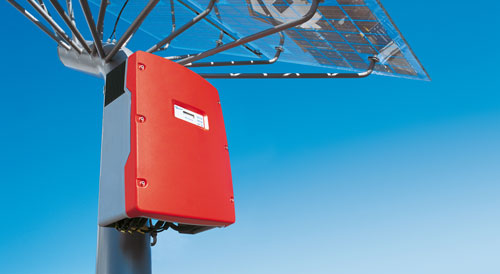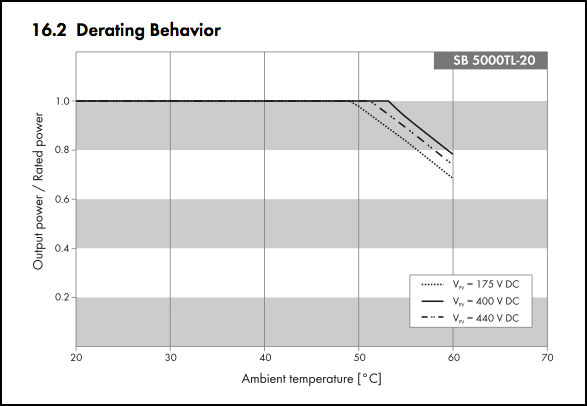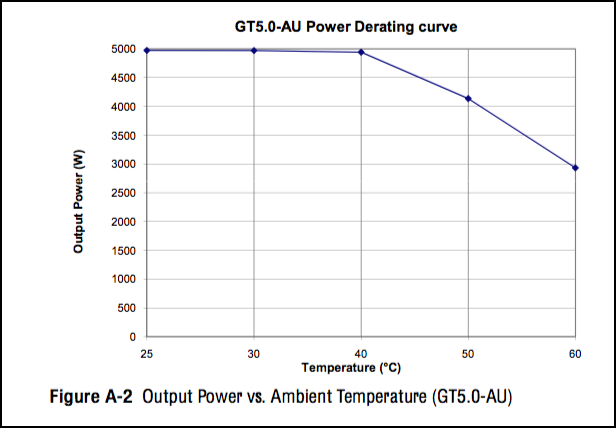If you’ve been reading this blog for any length of time you are probably already aware of how high ambient temperatures negatively affect solar panel performance.
But did you know that when it gets hot outside, those scorching Aussie temperatures can also cause the efficiency of your solar inverter to drop?
Many inverters are programmed to purposefully reduce their power output if they sense that they are overheating. This “feature” is called inverter temperature derating and they do it to protect their sensitive electronics from extreme temperatures.
Way back in the early days of grid connect solar power, in about 2002!, many inverters started to derate when the ambient temperature got over 25°C. Thankfully for us Aussies, technology has improved some and most decent inverters in 2012 won’t start to derate until the ambient temperature hits at least 40°C.
So how do you find out the temperature performance of your inverter, and do you need to worry about it?
It is actually really hard to find the temperature derating specs for most inverters, as it is not a standard entry on most inverter data sheets. However most inverter’s product manuals will have the info buried in them.
Here is the Temperature Derating Curve for a top quality, modern, tansformerless 5kW inverter, the Sunny Boy 5000TL
As you can see this inverter starts to derate at an ambient temperature of 50°C. I don’t know where you live, but here in Adelaide, the highest ever recorded temperature was just short of 47°C. So if you are lucky enough to a) live in Radelaide and b) have an SB5000TL inverter, then as long as your inverter is placed in a shaded position it should never start to derate.
The critical point in the paragraph above is that your inverter should never be placed where the sun can cook it. I walk past solar installations almost every day where I see inverters positioned in direct sunlight. Always place your inverter in a shaded spot. It will perform better and last a lot longer.
Now let’s look at another 5kW inverter with a slightly worse temperature performance:
Here you can see that the Xantrex GT5.0 Inverter starts to derate at an ambient temperature of 40°C.
Does this mean that we should pay more for the Sunny Boy?
To answer that question you have to ask yourself how often it gets above 40°C where you live.
In Adelaide you probably get about 10 days per year over 40°C. So with the Xantrex I would lose about 5% of my power for 10 days of the year. This would cost me about $3 per year in lost income! Not worth worrying about I would argue!
What you need to know about inverters and temperature:
- Many inverters do derate their power output if the ambient temperature gets too high. But if the inverter is any good, it’s got to get bloody hot before it starts to derate.
- The derating temperature is usually buried in the product manual.
- The inverter should never be placed in direct sunlight or in an unventilated room or box.
- The inverter derating will only only affect you if where you live actually ever gets hotter than the derating temperature.
- If your inverter is only going to derate a few days a year then your lost power is such a small amount it isn’t worth worrying about.
Here are the derating temperatures for some inverters that are popular in Australia:
Modern SMA transformerless inverters: usually start to derate at 50°C.
Modern SMA HF Transformer based inverters don’t derate at all.
Samil Power River Inverters derate at 45°C
Delta Soliva inverters derate at 50°C




 RSS - Posts
RSS - Posts



Hi Finn, Great website, I’m going through quoting stage to put Solar on my home. We intend living here for the next 40 years so we think it is a sound investment. I was considering some of the cheaper deals on installation, but from taking most of your points into consideration we can now see if you want a good product with warranty and back up it will be better to pay that little bit extra. We are narrowing it down to three. I have a local installer who started his own business scheduled to give me my final quote Monday then we will decide in the next couple of weeks.Thanks Wayne
Dear Finn, I have just had a 3kw solar system installed. Brand of inverter is OMNIK. I live on Gold Coast Qld and the days have been beautiful and sunny. Panels are installed on north facing aspect with no obstructions. Inverter is outside and in direct sun. Output so far has never exceeded 1600kw but mostly it is 1400. I think I have been sold a dud, How can I find out whether the unit is any good.
Regards, Pete
Gold Coast, North Facing, 5kW in August should average 20kWh per day. Look at the kWh readings (not kW) and see what you’ve got for a typical August day. If it is much less than that, you’ve got a dud.
I explain the difference between kW and kWh here:
http://www.solarquotes.com.au/blog/kw-and-kwh-what-is-the-difference/
Hi Finn, your timing is perfect as we are now looking at doing the research to go ahead and will wait for your 3 contacts in our area. Love the website, very informative. Congratulations. Do you have an article about very cold weather and snow on the panels? I will continue to read your articles and may come across those issues. Thanks Suzanne
Hi Finn,
Is there any IEC or any other standard for measuring Temperature derating curve. How can we believe that the derating curve provided by inverter manufacturer is correct or not.
Kindly clarify.
Thanks in advance.
Ajay.
Finn
Interesting discussion on de-rating. I have a xantrex and it gets very hot. This is expected because it does not have a fan and relies on passive cooling via the front heatsink. IMHO, the xantrex starts derating sooner than indicated in the chart. On a hot still day with clear blue skies, it struggles to get 4500W (I have 6 kW of panels). On a partly cloudy day, it will bounce up to 5 kW as soon as the panels get full sun. I reckon this is because the heatsink and panels are cooler but it is hard to tell which is having the greater effect. Still, when it is 30C and around midday, the heatsink is so hot you cant touch it (ie 60-70C plus) and I would be surprised if it is not backing off to limit temperature rise.
tim
G’day Finn,
Great article. I’ve been searching the web for details to explain why my inverter’s output power fluctuates significantly on a warm sunny summer day in Canberra and I think you have answered my question.
I have a Solar King SLK-3000 (3KW Inverter) mated with 14 x 215W German Solar panels. I average around 17 to 18KW a day in December/January and occasionally and surprisingly peaks at 20KW a day on a slightly overcast/cooler day around this time of the year. The only time the inverter hits 3KW (max output power) is when there is some cloud cover which I assume is helping in reflecting more sunlight.
Recently I noticed that my inverter’s output power was peaking to 2.5KW and then suddenly dropping to 1.6KW even though there were no change in clouds or shade cover to explain the sudden drop. Occasionally, the inverter would disconnect and count down from 60 seconds to reconnect again.
At that time I touched the back of the inverter (heatsink) and almost suffered 3rd degree burns to my fingers. It was so hot that I could not bare holding it for more than 2 seconds. I used the garden house to cool it down and the water that came out of the other end of the heatsink was hot enough to boil an egg. Within 30 seconds of running water on the heatsink the temperature stabilised and the heatsink temperature was cool again. Also, the inverter output was stable again at 2.5~2.6KW without fluctuating as before.
My Inverter is right next to my power switchboard which is facing north and in direct sunlight for most of the day. will it help to create a shade for it? or will that block the circulation of air? or should I organise to move it altogether to another location?
Can I install it on the inside of that wall which is inside the rumpus room? or is it illegal to install an inverter inside the house? Please note that the rumpus room used to be a garage which I have recently converted to a rumpus room.
I look forward to your advice.
Cheers,
Jimmy.
HI Jimmy,
Yes – get it out of the sun. Inside a cool garage is best. At the very least put some shade over it. It won’t affect the ventilation as long as you don’t put it in a box.
If you do move the inverter this article may help:
http://www.solarquotes.com.au/blog/where-should-your-solar-inverter-go-and-should-you-worry-about-voltage-drops/
Hope That Helps,
Finn
HI Finn,
Do you have a Derating Graph for thr Aurora PVI 5.0 OUTD ?
They derate with an ambient temperature over 50degC. I don’t have the curve, but their datasheet is here:
http://www.power-one.com/sites/power-one.com/files/documents/renewable-energy/datasheet/pvi-5000_6000-tl-en.pdf
Hello Finn,
What would happen if water (from the rain) got into the combiner box?
TQ. Karen
A short circuit, which can cause all sorts of problems. Such a system should be isolated and checked out by a CEC accredited sparky ASAP.
Well I am in shock.
My new system SMA 500TL is showing 64C on the Oxley app I have installed on my Smartphone.
It has been like this since day one and it sits in my garage.
The only time I see it lower than 40C is when it stops producing power so my question is could this Oxley app be incorrect as the SMA Explorer app does not give me any temperature readings ?
Is there any other way of checking ?
Power electronics do run hot. Another way to check would be with an infra red thermometer:
https://en.wikipedia.org/wiki/Infrared_thermometer
Sorry to unearth an old thread but I have a similar question for a similar reason.
I’ve noticed a gradual drop in power output over the years and wondered if the inverter might be the issue. I have had the Oxley app for a while and never really paid attention to the temperature reading until now. A few days ago I was looking at the app in the early morning, just before power generation began, and noticed that the reported temperature was about 43C. Ambient temperature would have been around 20C.
In the middle of the day (27C maximum) the inverter temperature got over 60C. I expect the inverter to get hot at full power, but does it sound normal to be that warm first thing in the morning?
Hello SgtThursday, Ronald here.
Looking online I see some people saying their inverters get that hot, but personally I’d be concerned and would check with the manufacturer if that is normal. If the inverter is exposed to sunlight I’d definitely recommend putting a shade over it. But it is possible the readings are simply off and I’d suggest checking to see if it feels warm next time you get a reading of 40+ degrees before its even started producing power in the morning.
Thanks Ronald,
It is in a shaded area with good airflow. This morning (~7am with clouds and smoke from yesterday’s bushfire) I approached it with an IR thermometer…
The temperature of the wall near the inverter (for reference) was 25-26 degC. I scanned every external part of the inverter (the front, the sides and as far as I could see behind and under) and couldn’t get a max temperature anywhere above 26.5 degC. Reported temperature was 51 degC at a power output of 50-70 W.
I guess either the reported temperature is wrong, or the temperature sensor is deep inside the inverter where the temperature could be quite a bit higher. I am wondering if the internal airflow is restricted by dust, cobwebs etc. or whether this is just normal? It’s an SB3000TL-20, installed 2011 with 32.2 MWh on the clock.
Being an engineer by trade I’m conscious that access to data that’s never been looked at before sometimes spins you off into trying to solve problems that don’t exist, so it’s possible that this is nothing to be concerned about. Nonetheless I think my inverter may have a date with a vaccum cleaner.
Cheers…
Looks like its good. The Sunny Boy TL 3000 doesn’t have a fan, but 7 years is more than enough time for it to get clogged up with spider webs and who knows what and reduce air circulation, so a clean sounds like a good idea.
New information. I worked out how to use the Oxley app to upload my info to PVOutput.org which now keeps a nice record of my reported i0nverter temperature.
Today (first good clear day since I started tracking) I compared the reported temperature rise in the inverter with the Bureau of Meteorology reported temperatures for Perth.
Inverter 6am (shortly after starting to output power) = 45.7 degC
Inverter peak temperature (2:45 PM) = 59.5 degC
Delta from 6am to maximum = 13.8 degC
BoM Perth 6am = 16.1 degC
BoM Perth peak (4:30 PM) = 30.0 degC
Delta from 6am to maximum = 13.9 degC
So… I think I’m not going to bother chasing this any further. It’s possible that the temperature reading in the inverter is misleading, but it doesn’t seem like the heat gain over the day is unusually large. I expect the heat is dissipating just fine.
I did give it a quick dust but that’s about it. It was nowhere near as dirty as I would have expected, but it’s probably in a reasonably well-protected area.
Thanks for the chat!
Would blowing a fan on the inverter help keep it cooler reduce derating?
regards
Glenn
That could help but I doubt it would be very effective. The best idea might be to make sure it is shaded and clean off any cobwebs and dirt that could block air circulation.
Hi Ronald
My Goodwe inverter is only a month old so I believe the air circulation is ok but I put a fan on the inverter today and it dropped the temp from about 59 C to 49 C. I was wondering if this made any difference to the inverters performance and by how much? eg the fan is ~100w, do you think cooling the inverter by 10C would improve the output by more than a 100w?
regards
Glenn
Hi Glen
I take it the temperature you were looking at was the inverter’s internal reading? I haven’t checked for every Goodwe inverter but they shouldn’t derate until the air temperature is over 45 degrees, assuming the unit is in the shade. If you find that blowing a fan on it does reduce its temperature by 10 degrees then on a hot day when it is derating it looks like it could be worthwhile to use the fan.
Hi Finn,
Love reading your advice!
New to this topic. We have recently installed a Fronius Primo Inverter and the only place I had available for mounting was on the east driveway side (our house faces NE and we don’t have a garage). The invertor gets direct sunlight in the morning till about 11.30 (summer). Im just wondering is it generally OK for the invertor to get partial sunlight and I guess its better to have morning sun rather than afternoon sun?
Also, I was thinking of getting an invertor box that allows for ventilation. Will that help with the shading? https://covermyinverter.com.au/product/universal-cover-small-solar-inverter-cover-surfmist-fcc07/?gclid=CjwKCAiA55mPBhBOEiwANmzoQj08YPZN8D0wjDnbY_YnDi0ykiAaz55PqCeFlrfUAq74YEFgTfWd2hoCKR4QAvD_BwE
Any advice would be greatly appreciated! Thank you
Cheers
Dong
Hi Dong
Having an inverter mounted on the east side of a building where it only gets sun in the morning is a good compromise. You are right that it is better for it to be exposed to morning sun than afternoon sun, as afternoons are warmer. Also — apart from one or two unusual exceptions — having an inverter mounted in the sun won’t affect it’s warranty. But, all else equal, you can expect an inverter mounted in the shade to last longer.
Having a shade cover is an excellent idea for one that is in full sun. For one that is only exposed in the morning it will help but you’ll have to decide if the increased life you will hopefully get out of it will be worth the expense. If you highly value peace of mind get one. If you are on a budget you may not want to worry about it because, when it eventually does fail, a replacement inverter will — hopefully — be considerably cheaper in the future.
Thanks Ronald! Definitely a peace of mind thing for me. Its also on my visually exposed driveway side so having a cover will hide it and make the edge cleaner. Cheers